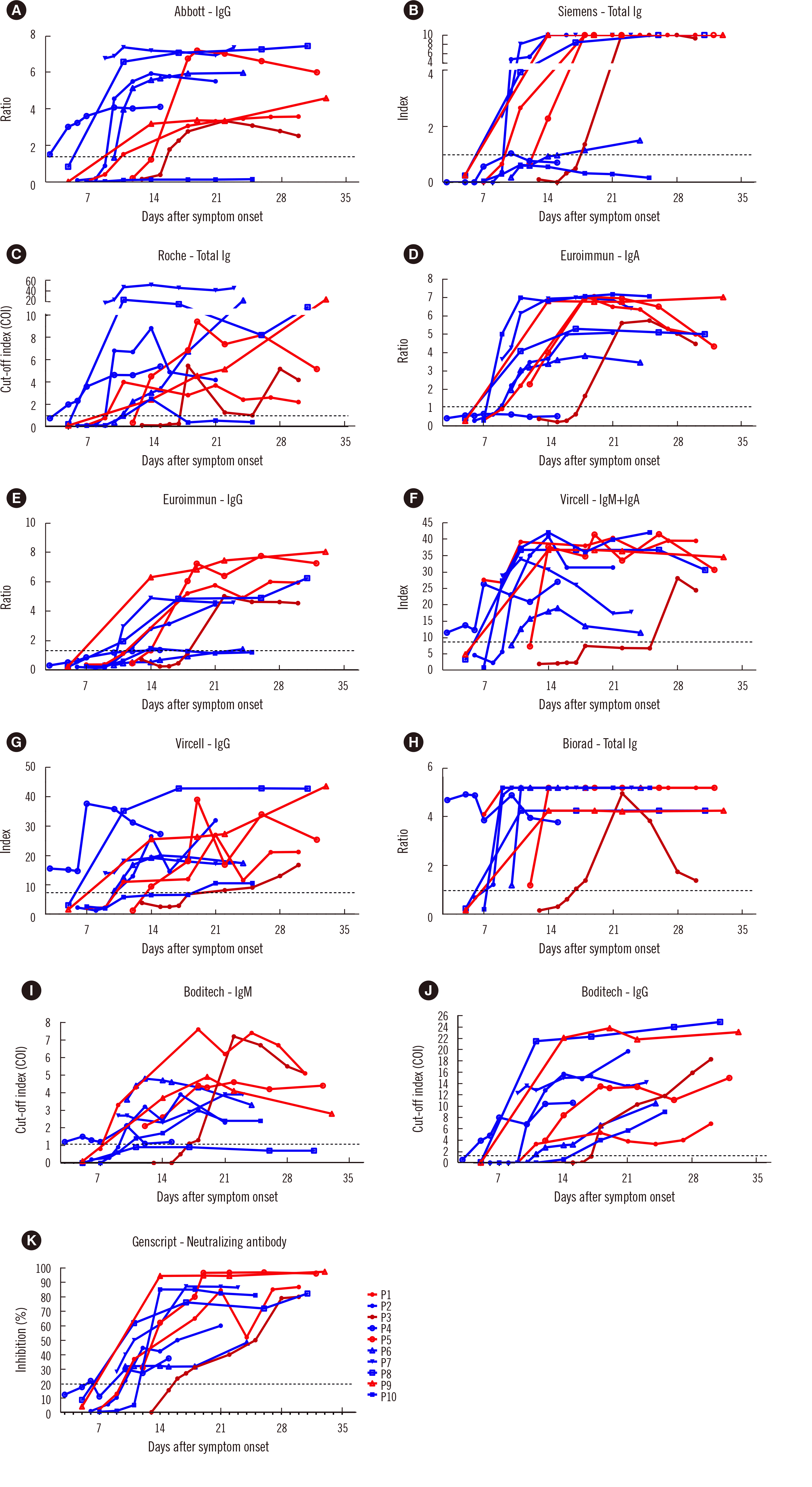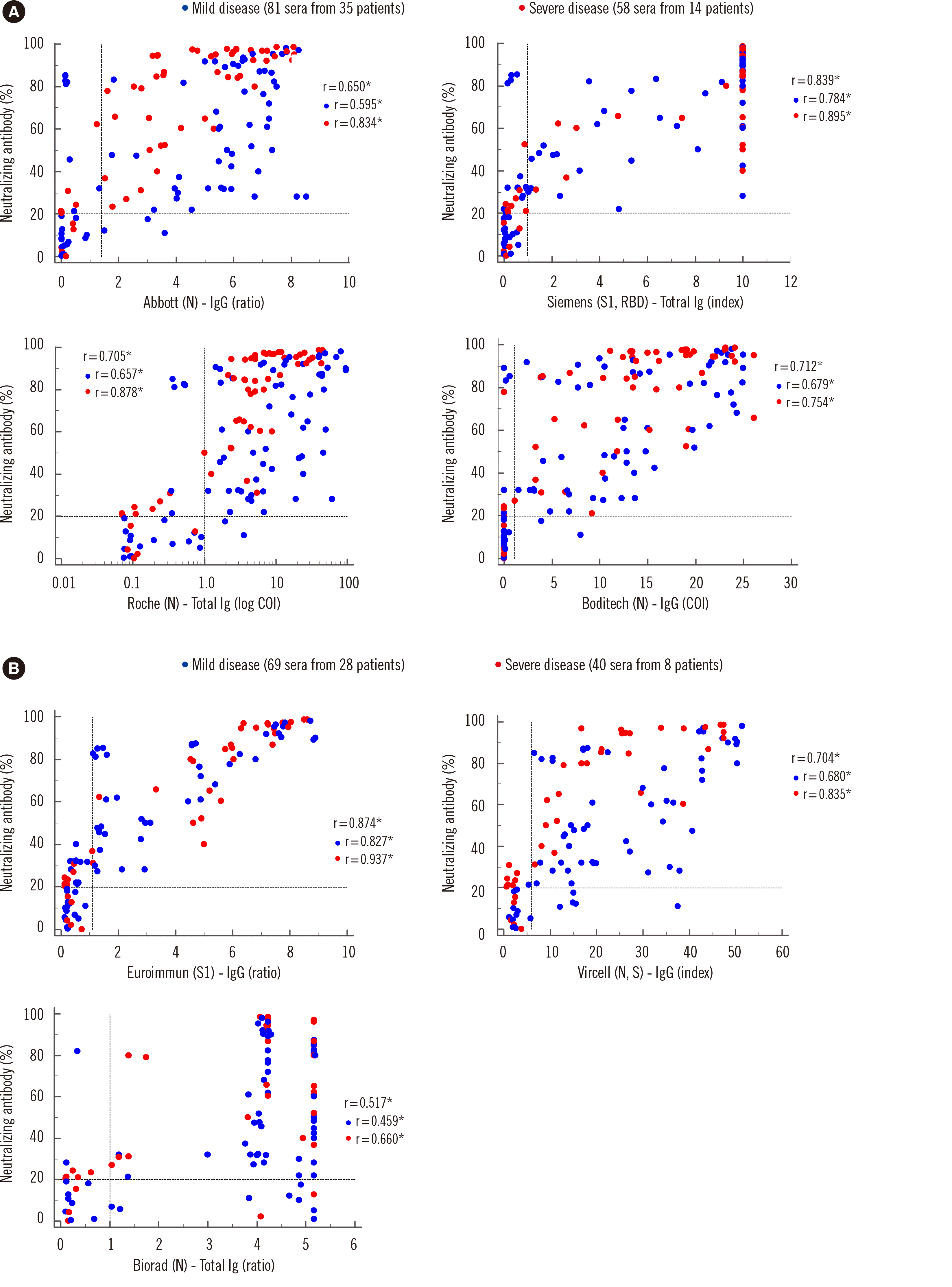1. Wu Z, McGoogan JM. 2020; Characteristics of and important lessons from the coronavirus Disease 2019 (COVID-19) outbreak in China: summary of a report of 72 314 cases from the Chinese Center for Disease Control and Prevention. JAMA. 323:1239–42. DOI:
10.1001/jama.2020.2648. PMID:
32091533.
2. Fong CH, Cai JP, Dissanayake TK, Chen LL, Choi CY, Wong LH, et al. 2020; Improved detection of antibodies against SARS-CoV-2 by microsphere-based antibody assay. Int J Mol Sci. 21:6595. DOI:
10.3390/ijms21186595. PMID:
32916926. PMCID:
PMC7555114.

3. Tu YF, Chien CS, Yarmishyn AA, Lin YY, Luo YH, Lin YT, et al. 2020; A review of SARS-CoV-2 and the ongoing clinical trials. Int J Mol Sci. 21:2657. DOI:
10.3390/ijms21072657. PMID:
32290293. PMCID:
PMC7177898.

4. Trabaud MA, Icard V, Milon MP, Bal A, Lina B, Escuret V. 2020; Comparison of eight commercial, high-throughput, automated or ELISA assays detecting SARS-CoV-2 IgG or total antibody. J Clin Virol. 132:104613. DOI:
10.1016/j.jcv.2020.104613. PMID:
32942137. PMCID:
PMC7476603.

5. Charlton CL, Kanji JN, Johal K, Bailey A, Plitt SS, MacDonald C, et al. 2020; Evaluation of six commercial mid- to high-volume antibody and six point-of-care lateral flow assays for detection of SARS-CoV-2 antibodies. J Clin Microbiol. 58:e01361–20. DOI:
10.1128/JCM.01361-20. PMID:
32665420. PMCID:
PMC7512179.

6. Kohmer N, Westhaus S, Rühl C, Ciesek S, Rabenau HF. 2020; Brief clinical evaluation of six high-throughput SARS-CoV-2 IgG antibody assays. J Clin Virol. 129:104480. DOI:
10.1016/j.jcv.2020.104480. PMID:
32505777. PMCID:
PMC7263247.

7. Tan CW, Chia WN, Qin X, Liu P, Chen MI, Tiu C, et al. 2020; A SARS-CoV-2 surrogate virus neutralization test based on antibody-mediated blockage of ACE2-spike protein-protein interaction. Nat Biotechnol. 38:1073–8. DOI:
10.1038/s41587-020-0631-z. PMID:
32704169.

8. To KK, Tsang OT, Leung WS, Tam AR, Wu TC, Lung DC, et al. 2020; Temporal profiles of viral load in posterior oropharyngeal saliva samples and serum antibody responses during infection by SARS-CoV-2: an observational cohort study. Lancet Infect Dis. 20:565–74. DOI:
10.1016/S1473-3099(20)30196-1. PMID:
32213337. PMCID:
PMC7158907.

9. Klimstra WB, Tilston-Lunel NL, Nambulli S, Boslett J, McMillen CM, Gilliland T, et al. 2020; SARS-CoV-2 growth, furin-cleavage-site adaptation and neutralization using serum from acutely infected hospitalized COVID-19 patients. J Gen Virol. 101:1156–69. DOI:
10.1099/jgv.0.001481. PMID:
32821033. PMCID:
PMC7879561.

10. Landis JR, Koch GG. 1977; The measurement of observer agreement for categorical data. Biometrics. 33:159–74. DOI:
10.2307/2529310. PMID:
843571.

11. Mukaka MM. 2012; Statistics corner: A guide to appropriate use of correlation coefficient in medical research. Malawi Med J. 24:69–71. PMID:
23638278. PMCID:
PMC3576830.
12. Kim YJ, Sung H, Ki CS, Hur M. 2020; COVID-19 Testing in South Korea: Current Status and the Need for Faster Diagnostics. Ann Lab Med. 40:349–50. DOI:
10.3343/alm.2020.40.5.349. PMID:
32237287. PMCID:
PMC7169622.

13. Hong KH, Lee SW, Kim TS, Huh HJ, Lee J, Kim SY, et al. 2020; Guidelines for Laboratory Diagnosis of Coronavirus Disease 2019 (COVID-19) in Korea. Ann Lab Med. 40:351–60. DOI:
10.3343/alm.2020.40.5.351. PMID:
32237288. PMCID:
PMC7169629.

14. Huh HJ, Hong KH, Kim TS, Song SH, Roh KH, Lee H, et al. 2021; Surveillance of coronavirus disease 2019 (COVID-19) testing in clinical laboratories in Korea. Ann Lab Med. 41:225–9. DOI:
10.3343/alm.2021.41.2.225. PMID:
33063685. PMCID:
PMC7591284.

15. Choudhary S, Sreenivasulu K, Mitra P, Misra S, Sharma P. 2021; Role of genetic variants and gene expression in the susceptibility and severity of COVID-19. Ann Lab Med. 41:129–38. DOI:
10.3343/alm.2021.41.2.129. PMID:
33063674. PMCID:
PMC7591285.

16. Cota G, Freire ML, de Souza CS, Pedras MJ, Saliba JW, Faria V, et al. 2020; Diagnostic performance of commercially available COVID-19 serology tests in Brazil. Int J Infect Dis. 101:382–90. DOI:
10.1016/j.ijid.2020.10.008. PMID:
33039612. PMCID:
PMC7544564.

18. Lee CY-P, Lin RTP, Renia L, Ng LFP. 2020; Serological approaches for COVID-19: epidemiologic perspective on surveillance and control. Front Immunol. 11:879. DOI:
10.3389/fimmu.2020.00879. PMID:
32391022. PMCID:
PMC7194125.

19. Plebani M, Padoan A, Negrini D, Carpinteri B, Sciacovelli L. 2020; Diagnostic performances and thresholds: the key to harmonization in serological SARS-CoV-2 assays? Clin Chim Acta. 509:1–7. DOI:
10.1016/j.cca.2020.05.050. PMID:
32485157. PMCID:
PMC7261100.

20. Zilla M, Wheeler BJ, Keetch C, Mitchell G, McBreen J, Wells A, et al. 2021; Variable performance in 6 commercial SARS-CoV-2 antibody assays may affect convalescent plasma and seroprevalence screening. Am J Clin Pathol. 155:343–53. DOI:
10.1093/ajcp/aqaa228. PMID:
33155015. PMCID:
PMC7665309.

21. Zhao J, Yuan Q, Wang H, Liu W, Liao X, Su Y, et al. 2020; Antibody responses to SARS-CoV-2 in patients with novel coronavirus disease 2019. Clin Infect Dis. 71:2027–34. DOI:
10.1093/cid/ciaa344. PMID:
32221519. PMCID:
PMC7184337.

22. Okba NMA, Müller MA, Li W, Wang C, GeurtsvanKessel CH, Corman VM, et al. 2020; Severe acute respiratory syndrome coronavirus 2-specific antibody responses in coronavirus disease patients. Emerg Infect Dis. 26:1478–88. DOI:
10.3201/eid2607.200841. PMID:
32267220. PMCID:
PMC7323511.

23. GeurtsvanKessel CH, Okba NMA, Igloi Z, Bogers S, Embregts CWE, Laksono BM, et al. 2020; An evaluation of COVID-19 serological assays informs future diagnostics and exposure assessment. Nat Commun. 11:3436. DOI:
10.1038/s41467-020-17317-y. PMID:
32632160. PMCID:
PMC7338506.

24. Bošnjak B, Stein SC, Willenzon S, Cordes AK, Puppe W, Bernhardt G, et al. 2021; Low serum neutralizing anti-SARS-CoV-2 S antibody levels in mildly affected COVID-19 convalescent patients revealed by two different detection methods. Cell Mol Immunol. 18:936–44. DOI:
10.1038/s41423-020-00573-9. PMID:
33139905. PMCID:
PMC7604543.

25. Tang MS, Case JB, Franks CE, Chen RE, Anderson NW, Henderson JP, et al. 2020; Association between SARS-CoV-2 neutralizing antibodies and commercial serological assays. Clin Chem. 66:1538–47. DOI:
10.1093/clinchem/hvaa211. PMID:
32894750. PMCID:
PMC7499494.

26. Brouwer PJM, Caniels TG, van der Straten K, Snitselaar JL, Aldon Y, Bangaru S, et al. 2020; Potent neutralizing antibodies from COVID-19 patients define multiple targets of vulnerability. Science. 369:643–50. DOI:
10.1126/science.abc5902. PMID:
32540902. PMCID:
PMC7299281.

27. Seow J, Graham C, Merrick B, Acors S, Pickering S, Steel KJA, et al. 2020; Longitudinal observation and decline of neutralizing antibody responses in the three months following SARS-CoV-2 infection in humans. Nat Microbiol. 5:1598–607. DOI:
10.1038/s41564-020-00813-8. PMID:
33106674. PMCID:
PMC7610833.

28. Luchsinger LL, Ransegnola BP, Jin DK, Muecksch F, Weisblum Y, Bao W, et al. 2020; Serological assays estimate highly variable SARS-CoV-2 neutralizing antibody activity in recovered COVID-19 patients. J Clin Microbiol. 58:e02005–20. DOI:
10.1128/JCM.02005-20. PMID:
32917729. PMCID:
PMC7685895.







 PDF
PDF Citation
Citation Print
Print



 XML Download
XML Download